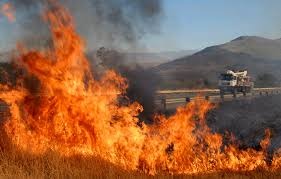In a significant effort to bolster the nation’s capacity for managing veld fires, the Environmental Management Agency (EMA) has released its latest Veld Fire Risk Prediction for 2024. Utilizing the Normalized Difference Vegetation Index (NDVI), EMA’s predictive modelling supports as a critical tool in forecasting potential fire outbreaks and devising strategies to mitigate both direct and indirect losses.
“The predictive modelling and risk assessment are crucial in guiding our preventative measures and response strategies. Our goal is to significantly decrease the devastation caused by veld fires through targeted interventions and community awareness programs” said EMA Environmental Education manager Amkela Sidange.
The prediction for 2024 indicates a concerning trend, with the majority of the country facing heightened risks. Specifically, 55.71% of the nation is categorized as high risk, while 18.6% falls into the medium risk category. Low-risk areas constitute 12.42%, and 13.27% of the country is identified as being in extreme high risk for veld fires.
Provinces that are particularly vulnerable include Mashonaland Central, East, and West, as well as Manicaland. Within these provinces, several districts are at extreme risk, namely Nyanga, Mutasa, Makoni, Mutare, Bindura, Makoni, Marondera, Chikomba, Hwedza, Harare, Zvimba, Mazowe, Centenary, Makonde, Hurungwe, Murewa, and Chimanimani.
Reflecting on the previous year’s data, the EMA reported that in 2023, veld fires ravaged a total of 858,361.9 hectares across 3,717 incidents. The average area affected per incident was 230.9 hectares, showing a slight improvement from the 233 hectares per incident recorded in 2022. Notably, there was a significant 50% reduction in the total area burnt in 2023 compared to the staggering 1,730,265 hectares destroyed in 2022.
Despite these improvements, the country did not meet its 2023 target of limiting burnt areas to 800,000 hectares or less, falling short by approximately 7%. For 2024, the EMA has set a more ambitious target, aiming to reduce the affected area to 700,000 hectares or less.



